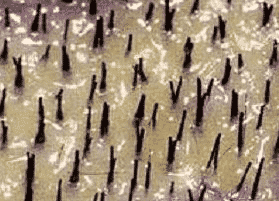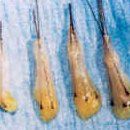Follicular UNIT TRANSPLANTATION
Follicular Units</strong>
The Key to Natural-Looking Hair Restoration: Follicular Units
Why Follicular Units Are Important
Human hair grows in small bundles called follicular units. Histologists have long recognized this, but many hair restoration surgeons have largely overlooked their importance in surgical procedures, impacting the effectiveness of traditional hair transplant techniques.

If you take a closer look at scalp hair trimmed to 1–2 mm, you’ll notice that hair grows in small bundles. These bundles typically contain 1, 2, 3, occasionally 4, and rarely 5 hairs per bundle.
These hairs, along with their support system (sebaceous glands, erector pili muscle, etc.), form what is called the follicular unit. Interestingly, these bundles of 1–5 hairs often exit the scalp through a single pore.
When viewed under a microscope, follicular units appear as distinct anatomical structures. Each unit is surrounded by a layer of connective tissue, which helps keep it intact. Maintaining the integrity of these units is essential to ensure maximum hair growth.
COMPONENTS
Each follicular unit contains the following:
- 1–5 terminal hairs.
- 1–2 fine vellus hairs.
- Sebaceous (oil) glands.
- A small muscle.
- Tiny nerves and blood vessels.
- A fine collagen band called the perifolliculum.
In genetically balding areas, healthy terminal hairs gradually shrink and are replaced by thinner, shorter strands called miniaturized hairs.
IMPORTANCE IN HAIR TRANSPLANTATION
 Both FUT (Follicular Unit Transplantation) and FUE (Follicular Unit Extraction) procedures require precise dissection of follicular units. This process ensures that all components remain intact for optimal survival and growth. When transplanted correctly, follicular units blend seamlessly with natural hair.
Both FUT (Follicular Unit Transplantation) and FUE (Follicular Unit Extraction) procedures require precise dissection of follicular units. This process ensures that all components remain intact for optimal survival and growth. When transplanted correctly, follicular units blend seamlessly with natural hair.
By using follicular units, hair transplantation produces consistent, natural-looking results. This approach utilizes the body’s natural building blocks, ensuring both reliability and aesthetic appeal.
Magnified View
 A magnified view of scalp hair trimmed to 1–2 mm reveals that hair naturally grows in small bundles of one to five hairs, with most containing one, two, or three hairs, and rarer cases having four or five hairs per bundle.
A magnified view of scalp hair trimmed to 1–2 mm reveals that hair naturally grows in small bundles of one to five hairs, with most containing one, two, or three hairs, and rarer cases having four or five hairs per bundle.
These hairs, along with their supporting structures such as sebaceous glands and the erector pili muscle, form what is known as the follicular unit.”. These 1-5 hair “bundles” usually exit the scalp through just a single pore!
When examined under a powerful microscope, these “Follicular Units” are clearly distinct anatomical entities, “individually wrapped” by a layer of (connective) tissue. The follicular unit serves as the hair-bearing structure of the skin and must remain intact to ensure maximum growth.
In addition to the full terminal hairs, the follicular unit contains 1-2 fine vellus hairs, sebaceous (oil) glands, a small muscle, tiny nerves and blood vessels, and a fine band of collagen that surrounds the unit (the perifolliculum). In genetically balding areas of the scalp, healthy terminal hairs gradually shrink and become finer, shorter strands known as miniaturized hairs.
 FUT hair transplants and FUE hair transplants require the precise dissection of each Follicular Unit, keeping all of its elements intact. This ensures optimal survival and growth of the hair and properly transplanted follicular units are indistinguishable from naturally occurring follicular units.
FUT hair transplants and FUE hair transplants require the precise dissection of each Follicular Unit, keeping all of its elements intact. This ensures optimal survival and growth of the hair and properly transplanted follicular units are indistinguishable from naturally occurring follicular units.
Using nature’s own building blocks for hair transplantation with follicular unit hair transplantation provides reliably good, natural results.
